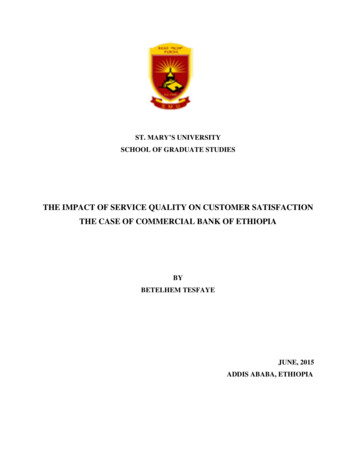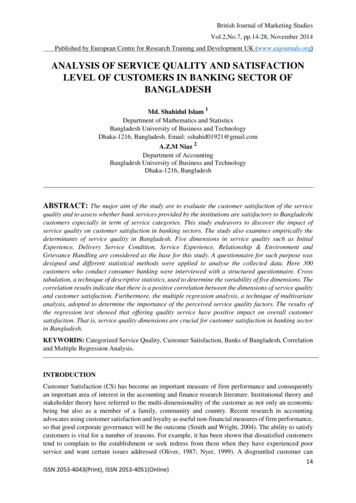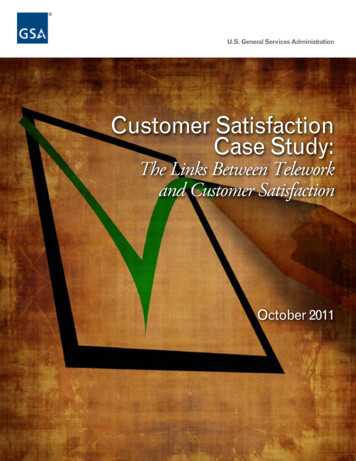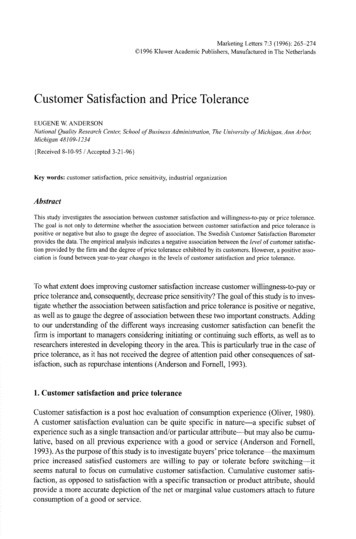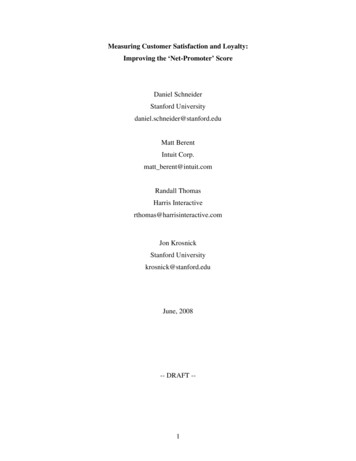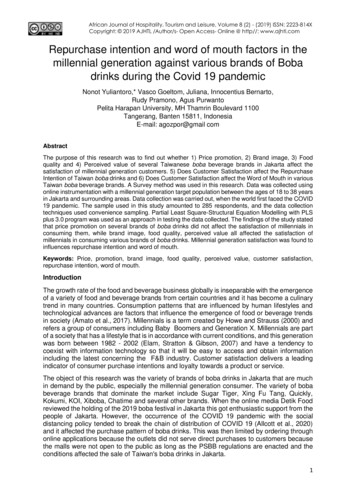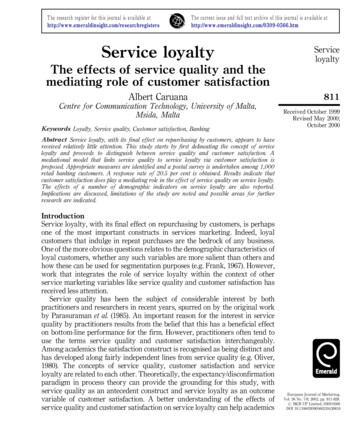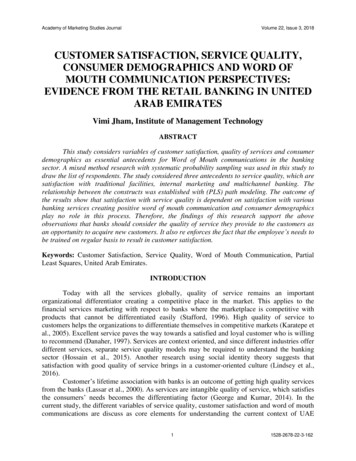
Transcription
Academy of Marketing Studies JournalVolume 22, Issue 3, 2018CUSTOMER SATISFACTION, SERVICE QUALITY,CONSUMER DEMOGRAPHICS AND WORD OFMOUTH COMMUNICATION PERSPECTIVES:EVIDENCE FROM THE RETAIL BANKING IN UNITEDARAB EMIRATESVimi Jham, Institute of Management TechnologyABSTRACTThis study considers variables of customer satisfaction, quality of services and consumerdemographics as essential antecedents for Word of Mouth communications in the bankingsector. A mixed method research with systematic probability sampling was used in this study todraw the list of respondents. The study considered three antecedents to service quality, which aresatisfaction with traditional facilities, internal marketing and multichannel banking. Therelationship between the constructs was established with (PLS) path modeling. The outcome ofthe results show that satisfaction with service quality is dependent on satisfaction with variousbanking services creating positive word of mouth communication and consumer demographicsplay no role in this process. Therefore, the findings of this research support the aboveobservations that banks should consider the quality of service they provide to the customers asan opportunity to acquire new customers. It also re enforces the fact that the employee’s needs tobe trained on regular basis to result in customer satisfaction.Keywords: Customer Satisfaction, Service Quality, Word of Mouth Communication, PartialLeast Squares, United Arab Emirates.INTRODUCTIONToday with all the services globally, quality of service remains an importantorganizational differentiator creating a competitive place in the market. This applies to thefinancial services marketing with respect to banks where the marketplace is competitive withproducts that cannot be differentiated easily (Stafford, 1996). High quality of service tocustomers helps the organizations to differentiate themselves in competitive markets (Karatepe etal., 2005). Excellent service paves the way towards a satisfied and loyal customer who is willingto recommend (Danaher, 1997). Services are context oriented, and since different industries offerdifferent services, separate service quality models may be required to understand the bankingsector (Hossain et al., 2015). Another research using social identity theory suggests thatsatisfaction with good quality of service brings in a customer-oriented culture (Lindsey et al.,2016).Customer’s lifetime association with banks is an outcome of getting high quality servicesfrom the banks (Lassar et al., 2000). As services are intangible quality of service, which satisfiesthe consumers’ needs becomes the differentiating factor (George and Kumar, 2014). In thecurrent study, the different variables of service quality, customer satisfaction and word of mouthcommunications are discuss as core elements for understanding the current context of UAE11528-2678-22-3-162
Academy of Marketing Studies JournalVolume 22, Issue 3, 2018(United Arab Emirates) banking. In order to generate a broader theory, a model based on thesatisfaction and service qualities of the bank taken as essential antecedents for Word of Mouthcommunications.According to Crosby and Stevens (1987), dimensions of satisfaction in a service industryare satisfaction with employee interactions, core services, and the organization. Therefore, tosatisfy a customer the banks need to differentiate their products and services (Levesque andGordon, 1996). To have a satisfied customer is a multifaceted work and there are multiplemoderators and mediators are required for this purpose (Kumar, 2016). New measurement toolslike GRID Scale been used to understand the service mixed satisfaction of customers with Bankservices (Audrezet et al., 2016). Researchers have proposed that customer satisfaction plays anintervening role between service quality and customer loyalty (Rajeswari et al., 2017)Research on Service quality and its consequences has received extensive academicfindings for over three decades. When the service quality need of customer is met, it results incustomer satisfaction and loyalty Haque et al. (2012). Another study suggested that quality ofservice finally decides the satisfaction of the customer and his length of association with theorganization (Ismail et al., 2016).It has established that a high quality of service provides benefits, which include enhancedcustomer satisfaction and positive word-of-mouth communication (Ilyas et al., 2013). Researchby Syed Muhammad Fazal-e-Hasan et al. (2017) suggests that thankfulness by the customer andhis brand affinity improve positive word of mouth communications. This research focuses on theeffect of satisfaction of the customer with service quality. It is therefore crucial that bankmanagers and other service providers understand how customers evaluate satisfaction with bankservice and link it to the quality of service. It has found that familiarity with the language leadsto word of mouth communications that are beneficial to the organization (Lassar et al., 2017).LITERATURE REVIEWResearch in customer satisfaction literature has conducted in retail environments (Oliver,1981). The few studies that look at the financial services industry are mainly concerned withretail banking (Caruana, 2002). Improved service quality leads to customer satisfaction whichresults in word of mouth communication (Berry and Parasuraman, 1991).Practitioners and market researchers (Dabholkar et al., 1995) have done theoretical andpractical research in the area of customer satisfaction. Therefore, in strategy formulationscustomer satisfaction and customer retention play an important role.Positive disconfirmation with service of the bank leads to the continuity of therelationship and positive communication by the customer whereas the negative one results in thediscontinuity of the relationship and negative recommendations (Jamal and Naser, 2002;Levesque and Gordon, 1996).According to Taylor and Baker (1994), the antecedents of customer satisfaction are thevariables underlying satisfaction, which are global rather than specific to a brand. Demographicfactors affect the general mindset of individuals, with each unique combination of demographiccharacteristics differentially shaping an individual’s perspectives. Such perspectives influenceexpectations, perceptions, and behavior. In a study on factors influencing bank selection ofIslamic banking products in South Africa, Saini et al. (2011) found that many variables ofService Quality determine the selection of banking institution, and that these determinants varybetween people with different demographic characteristics (Naser et al., 1999).21528-2678-22-3-162
Academy of Marketing Studies JournalVolume 22, Issue 3, 2018Demographic subgroups of gender and age have significantly different expectations formany unique dimensions of banking service, indicating that demographic characteristics shapeservice standards (Stafford, 1996). Demographic differences in perceptions of banking service,satisfaction, and customer loyalty are evident across age groups and education levels (Caruana,2002). According to findings from a study on service quality and demographics of customers ofprivate sector banks in Chennai, India, by Balaji and Babbu (2012), customers differ indimensions of service quality perceptions across income, occupation, education level, age,gender, and marital status.Lal et al. (2014) found that Indian banking customers overall service quality perceptionsare the same across all demographic subgroups for age, gender, marital status, income,education, and occupation. However, when investigating the individual dimensions of functionalservice quality, demographic differences are present for age, marital status, income, andeducation. There are demographic differences in banking customers’ satisfaction with variousaspects of Jordanian Islamic banks across age group, gender, and occupation, but no differencesexist in satisfaction across nationality or religion (Naser et al., 1999). Research does not suggestany impact of gender in a retail banking service. Hence, the effect of gender on customersatisfaction and loyalty remains an area of research where gap exists. In a recent research in thearea of banking, it was found that functional quality had higher impact on customer satisfactionwhen compared to technical quality. Thus, customer satisfaction was found to have impact oncustomer loyalty (Kasiri et al., 2017). Service quality is a measured and assessed on the basis ofservice delivery which matches the expectations of the customers (Lewis and Booms, 1983) andcustomer service quality and value creation affect customer satisfaction (Roy et al., 2011).Delivering quality service means conforming to customer expectations on a consistentbasis. According to Parasuraman et al. (1985) the literature provides conceptual development ofservice quality as the result of the comparison between delivered and expected serviceperformance. Under the framework of the disconfirmation, the paradigm models of perceivedservice quality by Oliver (1980), the Nordic by Gronroos (1982) and the American byParasuraman et al. (1985) dominate the literature. These models distinguish between “technical”and “functional” quality, reflecting the service outcomes and processes. Customers formperceptions of these dimensions based on corporate image. The “gaps analysis model” definesservice quality across five dimensions given by Parasuraman et al. (1985) as reliability,responsiveness, assurance, empathy, and tangibles. A by-product of the “gaps analysis model” isSERVQUAL a 22-item generic scale for measuring service quality as suggested by Parasuramanet al., 1988.Banks have to differentiate themselves based on services they provide. A recent researchusing GAPs model for service quality gave empirical evidence, which proved that banks have toenhance service quality in order to bring in customer satisfaction (Tan, 2017). The need of thehour for banks today is to have a bank specific widely known instrument to evaluate servicequality (Bahia and Nantel, 2000). This study considers functional quality (equivalent to what isoffered) as primary quality, because it is directly associated with the service provided. Similarvariables of service quality that affect satisfaction have studied in the health industry (Chen andTan, 2017).Word-of-Mouth communication (WOM) impacts the consumer’s buying behavior.Research proves that, one dissatisfied customer tells nine other people about the experiences thatresulted in the dissatisfaction. Satisfied customers, on the other hand, relate their story to anaverage of five other people (Knauer, 1992). This is particularly more important in the service31528-2678-22-3-162
Academy of Marketing Studies JournalVolume 22, Issue 3, 2018sector. Relying on WOM to reduce the dissonance about the service is common amongconsumers. Much of the research pertaining to WOM in the marketplace has focused onnegative, rather than positive, communication. Richins (1983) found that the tendency to engagein negative WOM was positively related to the level of dissatisfaction and negatively related tothe consumer’s perception of the retailer’s responsiveness to complaints. Evidence indicates thatreliability, tangibility, responsiveness has significant effect on WOM (Ren, 2016). A positivelink between satisfaction and loyalty has established in a research on airlines service industry by(Christian et al., 2011) (Table 1).Table 1COMPARATIVE ANALYSIS OF FINDINGS FROM OTHER STUDIESStudy VariableService quality is a measured and assessed on thebasis of service delivery, which matches theexpectations of the customers.Perceived service quality research.ReferenceLewis and Booms, 1983.Oliver (1980), the Nordic by Gronroos (1982) and theAmerican by Parasuraman et al. (1985).Berry and Parasuraman, 1991.Service quality leads to customer satisfaction whichresults in WOM.Satisfied customers relate their story to an averageof five other people.Antecedents of customer satisfaction.Customer Satisfaction and andards.Service Quality determines the selection of bankinginstitution, and that these determinants varybetween people with different demographiccharacteristics.There are demographic differences in bankingcustomers’ satisfaction with various aspects ofJordanian Islamic banks across age group, gender,and occupation, but no differences exist insatisfaction across nationality or religion.Positive disconfirmation with service of the bankleads to the continuity of the relationship andpositive communication by the customer.Customer service quality and value creation affectcustomer satisfaction.Banking customers overall service qualityperceptions are the same across all demographicsubgroups for age, gender, marital status, income,education, and occupation.Enhancement in service quality in order to bring incustomer satisfaction.Evidence indicates that reliability, tangibility,responsiveness has significant effect on WOM.Customer satisfaction was found to have impact oncustomer loyalty.Knauer, 1992.Taylor and Baker, 1994.Dabholkar et al. 1995.Stafford, 1996.Naser et al., 1999.Naser et al., 1999.Naser, 2002; Levesque & Gordon, 1996.Roy et al., 2011.Lal et al., 2014.Tan, 2017.Ren, 2016.Kasiri et al., 2017.41528-2678-22-3-162
Academy of Marketing Studies JournalVolume 22, Issue 3, 2018Limited research has suggested on impact of Consumer demographics on Word of mouthcommunication in a retail banking service. However, many studies exist on customer satisfactionand service quality but the study of customer satisfaction as an antecedent to service quality is aresearched area today. Hence, this research is trying to fill the gap in the literature by linkingcustomer satisfaction based on functional variables with quality of service, demographics andWOM.Objective of the StudyCronin and Taylor (1992) pointed out that good service quality results in a satisfiedcustomer and vice versa. Limited research is published taking satisfaction of the customer as anantecedent to quality of service and this research gap is covered by this study. Although anumber of studies have published where, service quality has taken as an antecedent to customersatisfaction.The link between service quality and customer’s behavioral intentions, combined with thelimited published research in this area, the purpose of this study is to understand the relationshipbetween customer satisfaction, quality of service, consumer demographics and their effect onword of mouth communication.The research in this paper establishes empirical tests with the key variables and theirrelationships as proposed in the existing literature. Quantitative and qualitative data werecollected from Five UAE banks and the research objectives addressed in the paper are tounderstand the drivers of Customer Satisfaction, and their relative impact on service quality andconsumer demographics. The study also makes an attempt to understand the drivers of ServiceQuality and Consumer demographics, and assess their impact on WOM communications withrespect to the banking sector.Theory DevelopmentMeasuring service quality in different ways and techniques has researched by severalscholars. The continuously changing environment requires an ongoing assessment of qualityfactors. In order to generate a broader theory, a model based on the relationship betweensatisfaction with the various services provided by the bank, quality of services, consumerdemographics and word of mouth communications were proposed in this research. Customersatisfaction, quality of service and consumer demographics were identified as antecedents forWOM.This theoretical approach means that customers assess the quality of services from theirexperience and if this is positive, they refer the bank to others. Several researchers have foundpositive relationship between service quality and customer satisfaction, which leads to referrals.Thus, relationships among these variables have established by several research studies (Kuo etal., 2009).Muthu (2010) have proposed that any service should provide good quality and includethe core service, employee commitment, updated technology, perceived tangibles and congenialenvironment concerns. Lenka et al. (2009) suggested use of employee interaction, technologyand tangible aspect of service quality. It has extensively researched that employees plays a keyrole in delivering services. Kaura (2013) recommended the use of people, process and physicalevidence as dimensions of service quality. There are two ways of measuring customer51528-2678-22-3-162
Academy of Marketing Studies JournalVolume 22, Issue 3, 2018satisfaction, one that deals with customer’s feedback about the product or service and otherwhich measures satisfaction on a single item rating scale, (Olsen and Johnson, 2003).Brown et al. (1996) and Lemmink and Mattsson (1998) found that customer satisfactionincreased with good employee behavior. A study conducted by Kaura and Datta (2012) foundthat positive impact on customer satisfaction was because of the employees. Research byCaruana and Calleya (1998) have found that employees who are not committed tend to harm theorganization, which results in poor performance due to bad service offerings. A recent study byGremler (2013) suggested that customer perceptions of employee emotional competencepositively influence customer satisfaction and loyalty. Satisfaction with online banking isrelated with satisfaction with physical banking (Rios, 2015). The studies conducted previouslyby researchers suggest that tangibility of services, technology, various touch points of banksinteractions, reliability, employee qualities and skills increase customer satisfaction (Bitner et al.,2000). Therefore, it can be prove that Customer Satisfaction with traditional facilities leads tosatisfaction with service quality, Customer Satisfaction with Multichannel banking leads tosatisfaction with service quality and Customer Satisfaction with Internal Marketing leads tosatisfaction with service quality.The first study of consumer demographics was conducted by Zeithaml (1985) analyzingthe effects of gender, age, and income. In retail banking evidence has found with demographicdifferences in perceptual image of bank service quality, satisfaction, and levels of loyalty acrossage groups and education levels (Caruana, 2002). Although these authors find significantdemographic differences, they determine that perceptions of bank service quality are notdifferent across gender or marital status. Private banking customers in Germany differ acrossemployment status and size of liquid assets in terms of variables of service quality constructs,value with service, satisfaction with services, and loyalty (Seiler et al., 2013). In addition, theseauthors have found that German private banking customer’s service quality perceptions are notdifferent across gender or age.Using SERVPERF, Havinal et al. (2013) found that customers of the commercial banksstate that no significant differences in these perceptions arise across age or gender. Lal et al.(2014) found that Indian banking customers overall service quality perceptions are the sameacross all demographic subgroups for age, gender, marital status, income, education andoccupation. There are demographic differences in banking customers’ satisfaction with variousaspects of Jordanian Islamic banks across age group, gender, and occupation, but no differencesexist in satisfaction across nationality or religion (Naser et al., 1999). However, the authors statethat these demographic differences are only marginally significant and very small. There are nodemographic differences in the likelihood of patronizing Islamic banks across levels ofeducation, income, or gender. While some demographic differences are present, Bizri, M (2014)finds that only religion is a significant predictor of the likelihood of patronizing Islamic banks.Therefore, it can be proved that Consumer demographics impacts the customer satisfaction withtraditional facilities, Consumer demographics impacts the customer satisfaction with multichannel banking, Consumer demographics impacts the customer satisfaction with internalmarketing and Consumer demographics impacts the WOM Communications.The main link between the long-term relationship between suppliers and buyers iscustomer satisfaction (Westbrook and Oliver, 1991). The customer gets motivated if satisfied bythe service provider and this leads to recommending the provider to other customers (Trif, 2013).The retail banking industry is one service industry where there is a tremendous potential toleverage WOM to reach out to people. With globalization and increase technology, orientation61528-2678-22-3-162
Academy of Marketing Studies JournalVolume 22, Issue 3, 2018service quality pressures of performing have increased in the banking professionals. Zeithaml etal. (1996) developed a conceptual model understanding the positive or negative effect of overallservice quality on WOM communications A recent study suggested that attitude of employeeswas the most important service quality attribute which resulted in positive WOM (Choudhury,2014). Therefore, it can be prove that Satisfaction with service quality leads to positive WOMCommunications.This study considered three antecedents to service quality, which are satisfaction withtraditional facilities, internal marketing and multichannel banking (Table 2). Satisfaction withquality of service leads to increase in positive word of mouth communications. The theoreticalmodel below in Figure 1 explains the research perspective.Table 2EXPLANATION OF CONSTRUCTSConstructSatisfaction with Traditional Marketing (TF).DefinitionsThe degree to which the consumer is satisfied with thetangibles and intangible aspect of service provided. Itreassures the customer of quality services when hephysically visits the bank.The degree to which the consumer is satisfied with servicesprovided by various touch points of the banks like ATM,mobile, internet, banking etc.The degree to which the consumer is satisfied withemployees’ behavior and customer service encounter.The quality of service as perceived by the customer ondimensions related to traditional facilities, multichannelbanking and internal marketing.Variables like education and occupation of the consumer.Reference given by the customer about the bank on havinga positive experience through word of mouth.Satisfaction with Multichannel banking (MCB).Satisfaction with Internal marketing (IM).Quality of banking service (Quality).Consumer demographics (CD).Word Of Mouth Communication (Refer Bank).71528-2678-22-3-162
Academy of Marketing Studies JournalVolume 22, Issue 3, 2018FIGURE 1THEORETICAL MODELDATA AND METHODOLOGYThe research process started with the literature review. The research done in the area ofcustomer satisfaction, service quality and word of mouth communication in the banking industrywere analyzed. The demographics variables and their importance in the study was ascertained. Aresearch mixed method design of research was used where qualitative and quantitative methodsof research were applied. The depth interviews were conducted with customers to explore theviews of the respondents with respect to customer satisfaction and service quality. The pilot testof the questionnaire was completed. The sampling was done and data collected for theexploratory study. Relationships were developed for testing. The theoretical saturation inqualitative research was achieved when the outcomes of the depth interview were enough toanswer the various questions of research. In quantitative research, the analysis of the dataindicated the saturation point.The questionnaire was designed from the results of the depth interview and the literaturereview (Johnston, 1995). Sixteen variables of satisfaction with the banks in UAE wereconsidered for the study. These banks chosen were customer centric in approach and had a strongretail presence.The data collected remained confidential. Data from 1000 customers were collected outof which 478 contacts were rejected because they were incomplete. The final questionnaire wasgiven to 522 customers of these banks in the month of September 2016. Out of which 494questionnaires were complete and the rest rejected. The sampling procedure used was Systematicsampling to draw the sample from the population.Questions related to experience while account opening were asked followed byrespondent’s satisfaction with respect to services provided, transaction variables, on semanticdifferential scale ranging from extremely good to extremely bad (7point scale, where 1extremely good, 7- extremely bad). This was followed by collection of demographic informationof the customer, which included variables like gender, marital status, monthly family income,age, education and occupation. The UAE banks open current accounts for salary and the bankprovides a saving account to its customers if they desire interest, which is just 0.25 %. Hence,most of the accounts are current accounts.The sample size consisted of 70% males and 30% females. The major category ofrespondents in the sample were married which was 51% and 49% were unmarried. 29%respondents had monthly income of AED 20000- AED 30000, 27% between AED 10000-AED20000 20% had income of less than AED 10000, and 24% had income between AED 30000AED 40000. 3.1% of the respondents were having associated with the bank for less than oneyear. 10.5% were between one and three years, 17.8% were between three and five years and68.6% were having transaction relationship with the bank for more than five years. 53% of therespondents were graduates, 39% were postgraduates and the 8% had not completed theirgraduation. 74% of the respondents were working in organizations such as government or privateand 26% were having business of their own. The average age of the respondents was between 22and 60 years.Data Analysis81528-2678-22-3-162
Academy of Marketing Studies JournalVolume 22, Issue 3, 2018Partial Least Square path-modeling algorithm does not require a normally distributed data(Fornell, 1994). Therefore, Smart PLS.2.0 was found ideal for allowing estimation ofmeasurement and structural model at the same time.The bootstrapping process identified the significant indicators that measure the latentconstructs using 494 sub samples. The procedure resulted in removal of two formative indicatorsrelated to internal marketing, multichannel banking and four reflective indicators pertaining toconsumer demographics. The indicators for consumer demographics (Table 3) used in this studywere gender (CD 1), marital status (CD 2), income (CD 3), age (CD 4), education (CD 5) andoccupation (CD 6). The outer loadings for all the indicators except education qualifications andoccupation were very insignificant, hence others indicators were removed. The outer loadings fordemographic variables can be seen in Figure 2. This also proves that in UAE, the occupation isskill based and educational qualifications are important. The marital status does not holdimportance as the accounts are opened for the people who have jobs and are salaried. The “t”values greater than 1.96 was found significant at 0.05 levels. The running of the PLS algorithmwas conducted which resulted in estimation of the model. The estimated model is presented inFigure 3 along with significant statistics. The assessment of the outer model was done beforeevaluating the structural model. The criteria for assessing reflective constructs and formativeconstructs was established. Table 4 below explains the assessment criteria for the reflectiveconstructs. Table 5 shows the value given to the constructs.Table 3CONSUMER DEMOGRAPHICS DATAConsumer DemographicsCD 1CD 2CD 3CD 4CD 5CD 6Variable nameGenderMarital StatusIncomeAgeEducationOccupationTable 4CRITERIA FOR ASSESSING REFLECTIVE CONSTRUCTSCriterionComposite Reliability.Indicator Reliability.Averagevariance extracted.FornellLarcker Criterion.Cross loadings.ConditionMore than 0.7 (Nunnally and Bernstein, 1994).Standardized outer loading should be more than 0.5(Hulland).More than 0.5.In order to ensure discriminant validity, the AVE of each latent variable should behigher than the squared correlations with all other latent variables.An indicator should not have higher correlation with another latent variable thanwith its respective latent variables.91528-2678-22-3-162
Academy of Marketing Studies JournalVolume 22, Issue 3, 2018Table 5REFLECTIVE CONSTRUCTS VALIDATIONReflectiveconstructsCDQuality of .92Discriminant validity Fornell Larcker,AVE0.530.57FIGURE 2DETAILS OF PLS PATH MODELLING (SMART PLS OUTPUT) SHOWING ALLDEMOGRAPHIC VARIABLESFIGURE 3DETAILS OF PLS PATH MODELLING (SMART PLS OUTPUT)101528-2678-22-3-162
Academy of Marketing Studies JournalVolume 22, Issue 3, 2018From the results of Smart PLS 2.0 output, the composite reliability of all reflectiveconstructs was more than 0.7 for both consumer demographics and quality of service, whichmeant good levels of internal consistency. The convergent validity (AVE) value for all thereflective constructs was above 0.5. The discriminant validity as established by Fornell-Larckerby Fornell (1981) criterion was met, all indicators loaded highest on their associated constructs.The assessment showed that the indicator reliability for all the indicators had loading of above0.7. Thus, the adequate quality for all reflective constructs used in the study was established.The PLS evaluation of the structural model is based on prediction oriented measures thatare non-parametric (Chin, 1998). The predictive capabilities of the model included R² and thecross-validated redundancy measure Q² (Hair et al., 2012). The R² values of the two constructsQuality of service, consumer demographi
Thus, customer satisfaction was found to have impact on customer loyalty (Kasiri et al., 2017). Service quality is a measured and assessed on the basis of service delivery which matches the expectations of the customers (Lewis and Booms, 1983) and customer service quality and value creation affect customer satisfaction (Roy et al., 2011).
